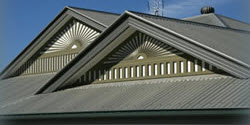Metal roof designs are not a newfound exterior fabrication. Dating back to 970 B.C., a metal copper roof was used on the temple in Jerusalem, expanding into an island phenomenon later in the Virgin Islands. Metal roofs were highly valued for a number of reasons. Instilled with enough strength to endure earthquakes, metal roofs also withstood powerful winds of tropical hurricanes, while maintaining an aesthetically pleasing appearance. When joined with Dutch designed peaked-roofs and an adequate drainage system, metal purified water was then stored in a container for household usage. In addition, metal was beneficially incorporated with fire resistant properties.
Since 1892, when metal roof designs became cheaper and more accessible, its use has increased, making it a more practical and adaptable roofing choice. Additionally, metal roofing has continued to grow increasingly in popularity. The most up-to-date metal roofing techniques including coatings, automated roll-forming, fastening systems, and sealants, that have radically decreased the price of metal roofs and only amplified its resourcefulness as the amount of textures, styles, and colors have swelled.
What exactly is Metal Roofing?
Metal roofing is identified by a number of metal-based roof casings designed to supply edifices with protection from the elements, to permit sufficient drainage of water from roof surfaces, and to keep inhabitants and substances comfortable and dry. Metal roofing products can be found in a broad range of metals such as copper, aluminum, zinc, steel, titanium, and stainless steel. With its projected longevity, metal roofing is a much desired and sustainable building component.
Metal Roof Designs
There are two fundamental metal roof design categories; structural and non-structural, or architectural.
Structural
Structural metal roofing fastens directly on to lathe boards or purlins and requires no solid support underneath. Non-structural metal roof designs require a dense substrate underneath, characteristically plywood, metal roof deck, or oriented strand board. Metal roofing can also be either standing seam or through-fastened.
Structural metal roofing is broken-down into steep slope and low slope groupings. Low slope products are less dense than steep slope designs. Low slope constructed metal roofing entails overlapping or interlocking panels that proceed vertically on the roof surface. These designs can have a clear acrylic finish, mill-finish, or painted finish.
Steep slope anatomic metal roofing is available in either horizontal or vertical profiles. The vertical-panels are comprised of standing seam systems fastened to primary purlins with concealed fastening flanges or clips. A broad range of facsimile or ridged metal roofs that are affixed with uncovered fasteners straight through the metal roofing-panels are also available. These products interlock or overlap on their sides and end-laps for water tightness.
Non-Structural Metal Roofing Designs
Many non-structural metal roof-panels are created for roof pitches. Rather than disperse loads through to lathe boards or purlins underneath them, non-structural designs shifts loads to the roof deck underneath them. Non-structural systems are obtainable in a number of designs including corrugated, vertical standing seams, and tile profiles along with a broad range of horizontal panels. The horizontal panels replicate the appearance of wood shake, tile, slate, and standard shingles. The majority of non-structural metal roofing will consists of a finish for durability and aesthetics. Finishes include numerous aggregate stone and paint varnishes.
Metal Roofing Designs and Aesthetics
Various metal roofs used in metal roofing such as aluminum is utilized for its malleability and corrosion resistance. Aluminum roofing usually has a paint varnish or anodization applied for tint and additional hardiness. Stainless steel, zinc, and copper, are commonly used without additional coatings. Copper is utilized for its resilience and characteristic glaze. Zinc is also used for its corrosion resistant properties, modest gloss gray appearance, and malleability. Stainless steel is used to attain a long-lasting, silver metallic, radiant guise, or to suit demands of a remarkably corrosive environment.
Metal roof designs are available in a vast amount of hues. Their visual appeal is certainly impressive. Various hues such as terra cotta, colonial red, slate blue, forest green, charcoal grey, mansard brown, and teal blue, are just some of the stunning colors that make metal roofing so versatile and visually alluring. You will find metal roof designs on numerous buildings and residences creating interesting structural patterns. Whether the edifice is traditional, contemporary, or colonial, metal roofing suits any structure naturally. For example, a brown metal roof on a dwelling with white trim creates a striking contrast. Metal roofing benefits include wind resistance, fire resistance, low weight, durability, and all-around visually attractiveness.

